Mastering Slow Cooker Brisket: A Step-by-Step Guide
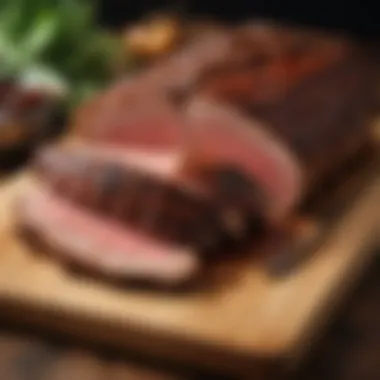
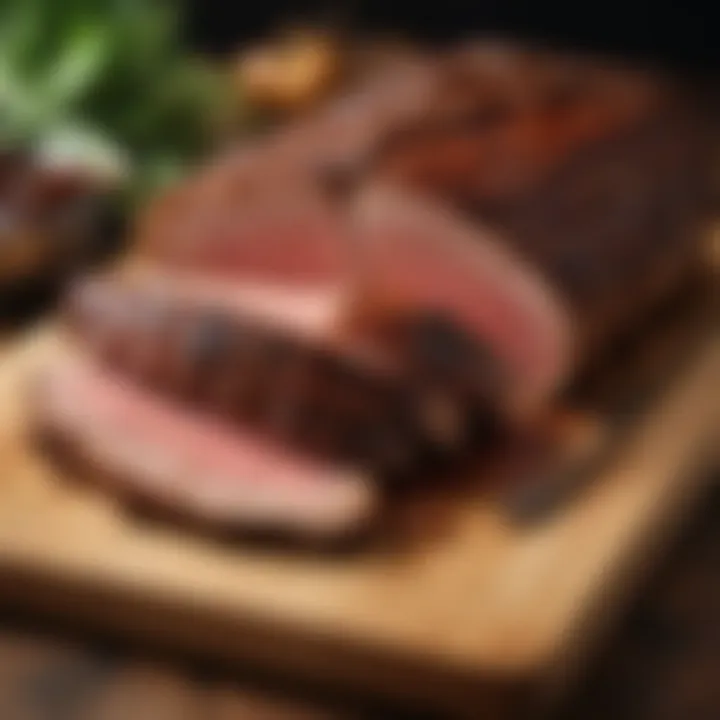
Intro
Cooking a brisket in a slow cooker can be an excellent way to achieve a delicious, tender meal with minimal effort. Brisket is a flavorful cut of meat, often used in barbecue and slow-cooked recipes. Using a slow cooker not only allows for hands-off cooking but also helps to retain the meat's juiciness, making it a favorite among many cooks.
This guide delves into how to prepare brisket efficiently using a slow cooker method. We will cover the essential steps, important techniques, and additional insights that can elevate your brisket cooking experience.
From selecting the cut to serving suggestions, every aspect will be discussed clearly and concisely, making this guide applicable for both novice and experienced cooks. Let’s explore the remarkable possibilities of cooking brisket in a slow cooker.
Understanding Brisket
Brisket is more than just a cut of beef; it is a culinary staple that embodies both tradition and flavor. Understanding brisket is crucial for anyone looking to prepare it in a slow cooker. The context of this understanding spans beyond mere cooking techniques. It provides insight into the meat's characteristics, the various cuts available, and how to identify quality brisket. Mastering these elements can transform a basic meal into a memorable experience.
What is Brisket?
Brisket comes from the breast section of the cow, specifically from the foreshank region. This cut of meat is known for its toughness, which can be intimidating for beginners. However, this toughness also means that brisket is full of flavor. When cooked correctly, particularly in a slow cooker, the collagen in the meat breaks down, resulting in tender, flavorful pieces.
Types of Brisket Cuts
Understanding the different types of brisket cuts is essential for preparing the dish successfully. Each cut has distinct features that contribute to the cooking process and the final flavor of the dish.
Flat Cut
The flat cut, also known as the first cut or lean cut, is the most common brisket cut. It has a uniform thickness, making it easier to slice when cooked. The key characteristic of the flat cut is its lower fat content in comparison to other cuts. This cut is often favored for its simplicity and ability to absorb marinades and rubs well. However, it may lack the richness some seek in a brisket.
Point Cut
The point cut is fattier and more marbled than the flat cut. It is sometimes considered to be more flavorful due to its higher fat content, which renders down during cooking, keeping the meat moist. The key characteristic of the point cut is its tenderness, especially when cooked low and slow. However, some may find it too fatty if they prefer leaner options.
Whole Brisket
Whole brisket includes both the flat and point cuts. It is popular for large gatherings because it offers more servings. This cut is versatile and allows for various cooking techniques, including smoking and braising. The main advantage is that it gives a mix of textures and flavors due to the combination of lean and fatty parts. However, it requires more attention and time to cook thoroughly compared to smaller cuts.
Choosing Quality Brisket
Selecting quality brisket is fundamental for a successful dish. The differences in quality can drastically influence flavor and tenderness. Factors such as freshness, marbling, and size are essential considerations.
Visual Indicators of Freshness
When assessing brisket, look for bright red color and minimal browning. Fresh brisket should also have a slight sheen. The key here is to ensure that the meat does not look dry or discolored. These visual indicators are important as they greatly contribute to taste and texture. Freshness can be a direct predictor of flavor quality.
Marbling and Fat Content
Marbling refers to the small streaks of fat within the muscle. High marbling in brisket indicates better flavor and tenderness as the fat melts during cooking. It is advisable to select cuts with a good amount of marbling. However, too much fat may result in excessive greasiness, so finding a balance is key.
Selecting the Right Size
Choosing the right size of brisket is essential based on the number of people being served. A rough estimate is about one pound per person if the brisket is the main dish. However, this can vary based on sides and personal preferences. Oversized briskets may take longer to cook and can be more challenging to manage in a slow cooker.
Understanding these factors when working with brisket will ensure that cooks can create a dish that meets their expectations for tenderness and flavor.
Preparing the Brisket
Preparing the brisket is a crucial step in the cooking process. This section delves into the essential actions required to transform your raw brisket into a beautifully cooked meal. Proper preparation can enhance flavor, tenderness, and overall enjoyment of the final dish. It involves thoughtful techniques like trimming excess fat, applying marinades or rubs, and seasoning correctly. Each of these elements contributes significantly to the outcome. Understanding how to prepare the brisket effectively will lead to a more satisfying culinary experience.
Trimming the Brisket
Trimming the brisket is an important first step. Often, briskets come with a layer of fat on one side. While some fat is beneficial for flavor, too much can make the meat greasy. Trim away the excess fat cap, leaving about 1/4 inch for moisture retention. This will allow the seasoning to penetrate better and result in a more flavorful brisket. Cutting off the tough silverskin can also help improve texture. It's important to use a sharp knife and be cautious during this process to avoid removing too much meat.
Marinades and Rubs
Marinades and rubs add depth to the flavor profile of brisket. They serve as a pre-cooking treatment that can take your dish from basic to exceptional.
Creating a Basic Marinade
A basic marinade typically includes three main components: an acid, oil, and seasonings. Acids like vinegar or citrus juice help to tenderize the meat while infusing it with flavor. The oil aids in moisture retention during cooking. Common seasonings may include garlic, onion powder, and even soy sauce for an umami kick. A simple marinade is beneficial because it requires few ingredients and minimal skill. While effective, it does require some marinating time to achieve the desired results. Generally, marinating brisket for at least a few hours or overnight maximizes its flavor impact.
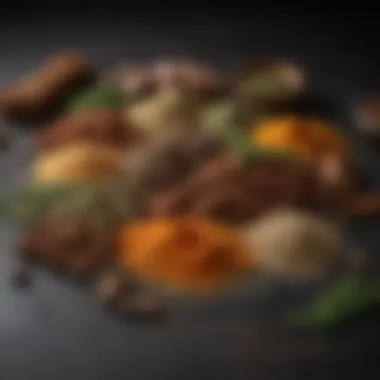

Applying Dry Rubs
Applying dry rubs is another effective technique for flavor enhancement. A dry rub is a mixture of spices and herbs rubbed directly onto the surface of the meat. This method forms a crust during cooking, providing a unique taste and texture. Common ingredients include brown sugar, smoked paprika, and black pepper. A dry rub is popular among cooks because it’s quick and allows for creativity in flavor combinations. However, it needs to sit for some time on the meat for maximum flavor penetration. Generally, applying the rub at least an hour before cooking is recommended.
Marinating Time Recommendations
The timing for marinating brisket varies depending on the type of marinade and personal preference. A short marinating time, around 30 minutes, gives a hint of flavor but lacks depth. On the contrary, marinating overnight or up to 24 hours provides a richer flavor and better texture. It's essential to consider food safety; if marinating for a long period, keep the brisket refrigerated. This way, one can enjoy a well-seasoned brisket that is safe and delicious.
Seasoning Techniques
Seasoning techniques will further enhance the brisket's flavor. The right balance of seasonings will create a flavorful crust that enriches the tender meat.
Salt and Pepper Basics
Salt and pepper form the foundation of seasoning for many meats, including brisket. Salt enhances the overall flavor and helps retain moisture during cooking, while freshly ground black pepper adds a slight heat and depth. It is vital to apply salt generously but not excessively. This combination is simple yet effective, making it a go-to method for many cooks. The primary advantage is its accessibility; these ingredients are commonly found in most kitchens. However, relying solely on salt and pepper may lead to a lack of complexity in flavor.
Herb and Spice Combinations
Using herb and spice combinations creates a unique flavor profile. Common herbs include rosemary, thyme, and oregano, while spices like cumin and chili powder can also enhance taste. A diverse blend of herbs and spices can elevate the flavor of the brisket, adding layers that a basic seasoning might miss. This technique is beneficial for those who want to experiment with flavors. However, it requires some knowledge of flavor pairings to avoid clashing tastes.
Adjusting Seasoning to Taste
Adjusting seasoning to taste refers to the practice of tasting and modifying flavors throughout the cooking process. It is essential because everyone's palate differs. Starting with less seasoning and adding more allows for control over the final taste. This technique is particularly useful when cooking for a group. The downside, however, can be that it requires confidence and experience to know when and how much to adjust. Nevertheless, it leads to a more personalized dish that can satisfy different preferences.
Using a Slow Cooker
The method of cooking brisket in a slow cooker offers several distinct advantages that cater to both convenience and culinary results. Unlike various cooking methods that require constant monitoring, a slow cooker simplifies the process by allowing for longer cooking times at lower temperatures. This ensures the brisket turns out tender, flavorful, and juicy, while freeing up valuable time for the cook to manage other tasks.
A slow cooker creates an environment where the meat cooks evenly and retains moisture. It is particularly advantageous for brisket, as this cut benefits from low and slow cooking. Additionally, it allows for a range of flavors to meld effectively, which enhances the overall taste of the dish.
Why a Slow Cooker?
Using a slow cooker is ideal for busy individuals or families. It makes cooking brisket much easier, requiring minimal effort. The primary advantage is its ability to break down the tough fibers of the meat over an extended period.
Furthermore, slow cooking promotes more robust flavors as the spices and seasonings have more time to penetrate the meat. This method is especially beneficial for those who wish to prepare meals in batches or plan ahead, as it can be set up in the morning and left to cook throughout the day.
Choosing the Right Slow Cooker
Capacity Considerations
Capacity plays a crucial role in selecting a slow cooker. A device with appropriate capacity should accommodate a brisket while leaving enough space for the other ingredients such as vegetables and liquids. Typically, slow cookers come in various sizes, ranging from 3 to 8 quarts. A 6-quart model is commonly preferred for brisket, striking a balance between accommodating larger cuts and ensuring even cooking.
A too-small slow cooker may lead to overcrowding, which can cause uneven cooking or extended cooking times. On the contrast, a significantly larger cooker may not retain heat as efficiently, affecting the cooking process. Thus, choosing the right capacity is essential for achieving the best results.
Settings and Features
Different slow cookers come with various settings and features that can impact cooking results. Many models offer low and high settings, facilitating flexibility in how brisket is cooked. A model with programmable settings can be beneficial, allowing cooks to choose specific time options that suit their schedules.
Additionally, some slow cookers come with features like temperature probes and automatic shut-off, enhancing usability and safety. These elements could mean the difference between a perfectly cooked brisket and one that is overdone or undercooked. Examining these settings in relation to personal cooking habits is crucial for optimal results.
Brand Recommendations
Selecting a reliable brand can aid in ensuring consistent results with a slow cooker. Renowned brands like Crock-Pot and Hamilton Beach have established a strong reputation for quality and durability. These brands often come with robust customer support and warranty options, which provide peace of mind.
Investing in a reputable brand can ensure longevity and performance. Some brands also offer specialized features that can enhance the cooking process, like searing capabilities or modular designs. Assessing brand reputation and customer feedback can assist in making an informed choice.
Slow Cooker Setup
Preheating Your Slow Cooker
Preheating is often overlooked but can be a key step in slow cooking. This process helps bring the cooking vessel up to the desired temperature before adding ingredients. A preheated slow cooker can jumpstart the cooking process, helping to achieve a better texture in the brisket.
Not all slow cookers require preheating, so verifying the manual can provide specific guidance. If preheating is recommended, it usually takes about 20 to 30 minutes. This strategy can be beneficial for those new to slow cooking.
Layering Ingredients
The way ingredients are layered in the slow cooker can affect their cooking. It is advisable to place heavier items like brisket at the bottom, as they need more heat. Aromatic vegetables like onions and carrots can be layered above to infuse their flavors into the meat.
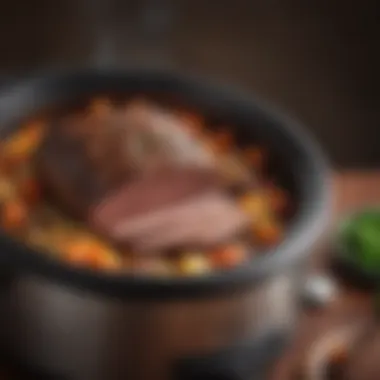
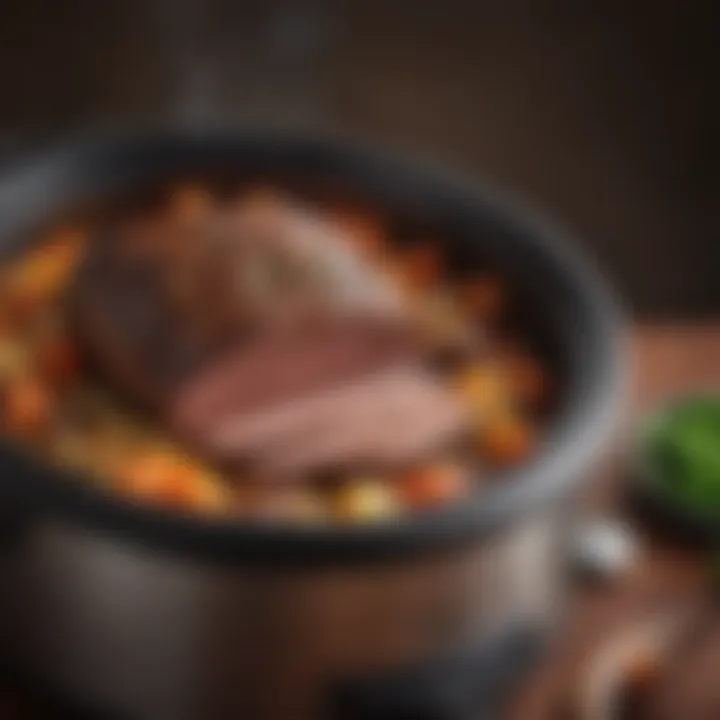
This strategic layering allows for even cooking, where the meat is tenderized while the flavors from the ingredients above seep down. Understanding layering can enhance the overall dish's quality significantly, allowing for a more complex flavor profile.
Liquid Requirements
Liquid is vital for a successful slow cooker recipe. It aids in the cooking process, ensuring that the meat does not dry out. Different liquids serve unique purposes, whether using broth for added flavor or wine for acidity.
Generally, a cup or two of liquid is sufficient, depending on the size of the brisket and the cooker. Too much liquid may lead to a stewing effect rather than roasting, impacting texture. Getting the balance right can importantly influence the final product.
Cooking Process
The cooking process is integral to the success of achieving tender and flavorful brisket in a slow cooker. It encompasses the timing, temperature, and continuous monitoring necessary for optimal results. Proper control of these elements ensures that the brisket is cooked evenly, allowing the meat to become tender while infusing flavors throughout the dish. Understanding how each aspect interacts allows cooks to fine-tune their methods and achieve mastery over this cooking technique.
Timing and Temperature
Low vs. High Settings
The choice between low and high settings on a slow cooker significantly affects the outcome of the brisket. Low settings allow for a gradual cooking process. This method slowly breaks down the collagen in the meat, resulting in a tender texture. It is beneficial for those who prefer to set their cooker and leave it for several hours. However, high settings, while faster, can lead to uneven cooking and tougher meat if not monitored carefully. The key characteristic of low roasting is a steady temperature, which helps flavors develop more fully over time, making it a popular choice for those looking to bring out the best in their brisket.
Recommended Cooking Times
Recommended cooking times vary based on the size of the brisket and the setting used. A general guideline suggests that a brisket cooked on low should take about 8 to 10 hours, while high settings may reduce this to 4 to 6 hours. The timing is a crucial detail that influences the final texture and flavor. By adhering to these times, cooks can ensure the brisket is adequately tender without risking overcooking. The unique feature here is that cooking too quickly can lead to drying out the meat, which is why following these recommendations is so critical.
Using a Meat Thermometer
Using a meat thermometer is an essential practice when cooking brisket. It helps ensure that the internal temperature reaches at least 195°F, which is crucial for breaking down connective tissues. This practice not only guarantees doneness but also prevents the risk of undercooked meat. The main advantage of using a meat thermometer is the precision it brings; it takes the guesswork out of the cooking process and allows for more predictable results.
Monitoring Progress
Checking Liquid Levels
Checking the liquid levels in the slow cooker is important to maintain moisture. Insufficient liquid can lead to burning on the edges of the brisket. A well-hydrated environment contributes to evenly cooked meat. The unique feature of this monitoring aspect is ensuring that flavors from braising liquids or marinades can permeate the brisket thoroughly. A key characteristic should be a consistent monitoring process, keeping track of evaporation and needs for adding more liquid.
Adjusting Seasoning Mid-Cook
Adjusting seasoning mid-cook is an effective technique for enhancing flavor. As the brisket cooks, the intensity of flavors might change. Therefore, this step allows cooks to taste and modify the seasoning as necessary. This method is significant because it enables personalized flavor profiles tailored to individual preferences. The unique feature is that it ensures the brisket remains well-seasoned throughout, maximizing the enjoyment of the meal.
Signs of Doneness
Identifying signs of doneness is essential for a successful brisket. The primary characteristic to look for is tenderness; when poked or sliced, the meat should yield easily. Additionally, the internal temperature achieved can further indicate readiness. This understanding is crucial, as pulling the brisket at the right time ensures it does not become dry. The advantage here is clear: with a focus on tenderness, cooks can be assured that the brisket will be juicy and flavorful upon serving.
A slow cooker brisket requires patience and careful attention to detail, yet it rewards with magnificent flavor and tenderness.
Post-Cooking Considerations
After the slow cooking process is complete, there are vital elements to consider for achieving optimum flavor and tenderness in your brisket. Post-cooking considerations focus on how the brisket is handled after it exits the slow cooker, enhancing both taste and texture. Understanding these factors ensures that the effort put into cooking does not diminish at the final stage.
Resting the Brisket
Importance of Resting
Resting the brisket is a crucial step after cooking. This process allows the juices within the meat to redistribute, preventing a dry result. When a brisket cooks, its muscles contract, pushing juices toward the center. By resting it, especially after a long cooking time, the meat retains more moisture when sliced. This is a popular method among chefs, as it maximizes the overall flavor experience.
Optimal Resting Time
Determining the optimal resting time for the brisket is essential. Generally, a period of 30 minutes to 2 hours works well, depending on the size of the cut. The key characteristic of resting is simple; it allows the heat to escape gradually. This unique feature avoids causing dry patches during slicing. Though it may seem like a delay, the benefits significantly outweigh the wait.
Covering Techniques
Using proper covering techniques while resting the brisket contributes significantly to maintaining its warmth. Foil tenting is commonly recommended, as it traps heat without steaming the meat. This method prevents the crust from becoming soggy, preserving the delicious exterior. Its advantage is clear; it keeps the meat warm and ready to serve.
Slicing Techniques
Slicing Against the Grain
Slicing against the grain is a critical technique for ensuring tender bites of brisket. When meat is sliced with the grain, it can result in long, chewy strands. By cutting against the grain, the fibers are shortened, providing a better texture. This approach is beneficial for maintaining the brisket's richness, making every piece enjoyable and easy to chew.
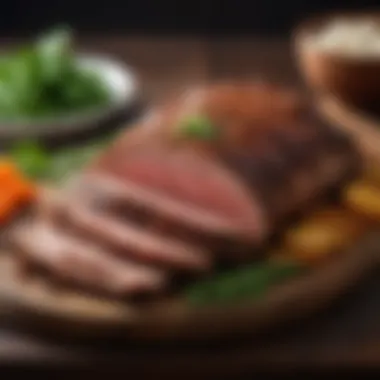
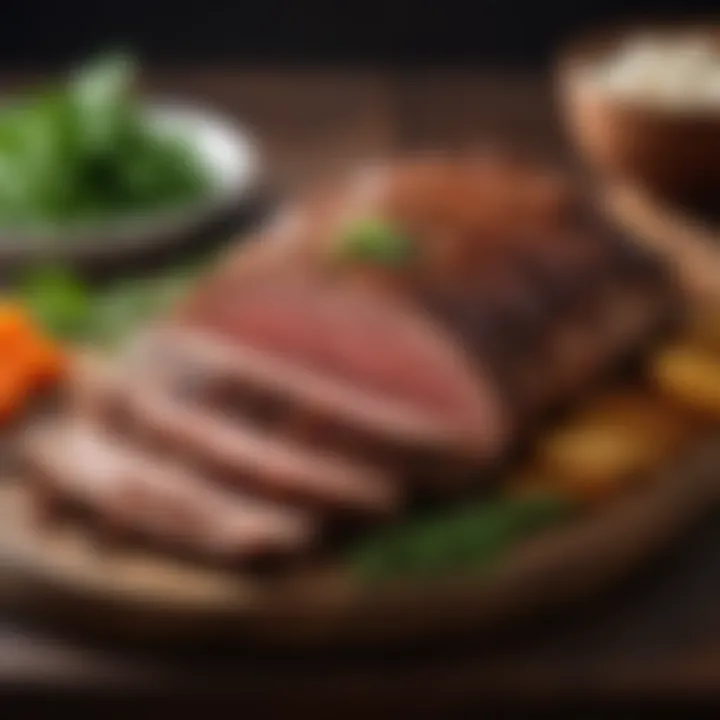
Proper Knife Selection
Selecting the proper knife is essential for achieving clean cuts. A sharp chef’s knife or a dedicated slicing knife provides the best results. The characteristics of these knives allow for smooth, precise slices. This kind of selection influences presentation and ease of serving. Chose wisely, as the right tool can elevate the entire dining experience.
Serving Sizes Guide
Lastly, understanding serving sizes is crucial for meal planning. A good guide is to allocate roughly 1/2 to 1 pound of cooked brisket per person, depending on the accompaniments. This core idea ensures everyone receives an adequate portion, minimizing waste and maximizing satisfaction. Knowing these proportions also aids in leftovers management.
The post-cooking phase is just as important as the cooking process itself. It can greatly affect the quality of the finished dish, making attention to detail vital for a successful brisket.
Serving Suggestions
Serving suggestions play a vital role in enhancing the overall dining experience when cooking a brisket in a slow cooker. The way brisket is presented and accompanied can significantly influence how it is perceived and enjoyed. By thoughtfully selecting side dishes and serving styles, one can elevate a simple meal into a memorable feast. This final section aims to provide valuable insights into complementary options that thereby enrich the main dish, ensuring that each bite of brisket remains delightful.
Complementary Side Dishes
Complementary side dishes are essential for rounding out the meal. They balance flavors and textures, creating an enjoyable experience.
Classic Pairings
Classic pairings like coleslaw and roasted potatoes stand the test of time. Their combination with brisket highlights the meat’s rich flavor without overwhelming it. These sides tend to have a crunchy or earthy character, which adds variety to the meal. For example, the creamy consistency of coleslaw can contrast nicely with the tender brisket, providing a refreshing bite.
These sides are practical due to their ease of preparation. Most can be made in advance, allowing for a smooth serving process. However, overloading the plate with too much variety may distract from the brisket, so balance is key.
Vegetarian Options
Vegetarian options serve as excellent complements for those who prefer plant-based dishes. Choices like grilled vegetables or a quinoa salad can enhance the meal. The unique feature of these options lies in their ability to add nutrition and color to the plate. They often carry lightness, which offers a nice contrast to the heavy brisket.
Inclusion of these dishes also makes the meal more inclusive, appealing to guests with various dietary preferences. Their preparation can sometimes involve more steps and seasonings, which requires careful attention to achieve the right flavor balance.
Creative Accompaniments
Creative accompaniments introduce an element of surprise to the meal. Options such as spicy black bean salsa or mango chutney can add an exciting twist to the traditional brisket plate. Their key characteristic is their bold flavors, which can heighten the main dish. This can make the experience more dynamic for the diners.
Though these options can be delightful, they require functional consideration, as not everyone may enjoy the same level of spice or sweetness. It’s important to gauge the audience's palate before offering these accompaniments.
Serving Styles
Once the brisket and sides are prepared, the question remains: how to serve them? The presentation can vastly alter the experience.
Plated Presentation
A plated presentation highlights the individual components of the meal. Serving the brisket alongside neat portions of sides allows for a careful arrangement on the plate. This method is visually appealing and encourages diners to appreciate each element. It showcases skill in presentation, making the dinner feel more formal or elegant.
However, this style may require extra dishwashing, as each diner has specific plating.
Sandwich Options
Sandwich options take a more casual approach while allowing for flexibility. Shredded brisket can be served on crusty bread with the addition of pickles and mustard or barbecue sauce. This method highlights the brisket and makes it comfortably portable for guests. It's beneficial for informal gatherings or picnics, as it is easy to assemble.
The downside is that not everyone may prefer their brisket in this format, which can limit how the dish appeals to varied tastes.
Barbecue Style Serving
Barbecue style serving taps into the essence of communal dining. Presenting brisket on a large platter encourages sharing and interaction among guests. The visual aspect of a whole brisket adds an inviting touch. It creates a warm and welcoming atmosphere, making it ideal for gatherings.
However, maintaining the brisket’s temperature can be a challenge. Mastering this style involves planning ahead to ensure everything stays hot during serving.
In summary, serving suggestions are not merely an afterthought but a significant aspect of presenting slow-cooked brisket. Thoughtful combinations of sides and serving styles can elevate the dining experience, ensuring that each guest leaves satisfied.
Epilogue
The conclusion of an article often serves as a crucial point of reflection. In the case of cooking a brisket in a slow cooker, it reinforces the methods and techniques discussed earlier. Understanding how to effectively utilize a slow cooker can transform a simple cut of meat into a flavorful, tender dish. It allows cooks of all skill levels to enjoy the benefits of great taste with minimal effort.
After covering all essential steps, from selecting the right cut to specific seasoning techniques, it is clear that slow cooking brisket not only elevates the cooking experience but also enhances the meal's quality. The advantages are significant as they lead to improved flavor and texture, which are imperative for a delighting dining experience.
Final Thoughts on Slow-Cooked Brisket
Slow-cooked brisket epitomizes what thoughtful cooking should be about. It respects the ingredients and highlights the skill of the cook. By investing time in slow cooking, one is rewarded with juicy meat, a rich depth of flavor, and a comforting dining experience. The steps taken to prepare have a direct impact on the final product.
The technique of using a slow cooker allows for flexibility in meal preparation. Cooks can set the slow cooker and attend to other commitments without missing out on great taste. Moreover, it makes generous servings accessible for gatherings, offering an option that pleases a variety of palates.
Overall, slow-cooked brisket showcases the harmony between simplicity and flavor. This guide fosters confidence among cooks and encourages experimentation with different spices, marinades, and serving styles. As one becomes comfortable with the process, they will find joy in both the cooking and the eating of this quintessential dish.







